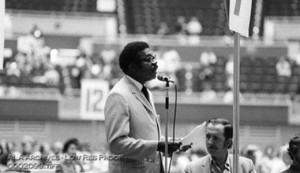
On Wednesday, Feb. 11, I spent the majority of the day at the headquarters of the Ford Foundation in New York City to participate in the launch of NetGain. This extraordinary effort—not sure whether to call it an initiative or budding movement—aspires to accelerate progress towards an equitable digital society. Stars from across digital civil society populated the day—from Sir Tim Berners-Lee to Susan Crawford to the presidents of the Ford, Knight, Mozilla and Open Society foundations. Even New York Mayor Bill de Blasio took part with a rousing welcome to the day’s events. Further information about NetGain may be found in this article in the Chronicle of Philanthropy.
Darren Walker, president of the Ford Foundation, led off the day with a concise characterization of the focus of NetGain. He talks about how “internet rights are civil rights” and that they are “an extension and expansion of our democracy.” Walker notes the many partnerships among many of the people attending the convening, but asks how can we collectively achieve much better outcomes. How can we work together more effectively in new partnerships towards a web that gives everyone an equal opportunity to be heard? What are the new initiatives, policy outcomes, designs, and so forth to pursue?
My initial reaction is that this concept is right on—the key to qualitatively faster and more impactful progress is leveraging and coordinating relatively independent efforts. This is a fine and needed strategic insight, but it only reflects on the efficiency benefits. Through closer coupling of work, momentum and energy also are created. This energy can help generate the characteristics of a movement that can also improve effectiveness, create excitement, and thereby attract broader resources and support.
Mayor de Blasio said that the analog era was not necessarily a time of great inclusion, equality, and fairness. While the digital age provides promise for a better future, there are no guarantees of better outcomes and, indeed, notes that we have now surpassed the roaring ‘20s in terms of inequality in society, in terms of economics and opportunity.
He said that today so many opportunities are absolutely correlated to education and internet access. New York is working to increase this access, such as the effort to transform pay phones into free wi-fi hotspots and to lend free wi-fi devices through New York Public Library. This kind of innovation and experimentation is key across the country, and from what’s learned, best practices must then be broadly shared and adopted, de Blasio concluded.
There was frankness with the nature of the challenges involved. When moderator Gwen Ifill asked about being behind and where foundations fit, several foundation presidents readily acknowledged that they are still largely in the analog world and that their organizations must evolve more quickly to reflect the opportunities and demands of the digital era. Many in the foundation world are not that comfortable with the technology. Also, neither the foundations nor anyone else have all the answers, and so we need to be bolder and more accepting of some failures along the road to creating lasting change.
Darren Walker said that we need to solve a lot of problems… there is not a silver bullet—rather a movement needs to be created to address the many big challenges, over a long period of time. Foundation work is based on spotting talent, building durable institutions, staying in for the long haul, finding and investing in ideas that foundation staff never thought about—and then how to best position foundations in this process.
The immediate next step is to identify the big ideas that need to be pursued. Everyone is invited to participate in the Netgain Challenge—you put on your thinking caps and submit. During the session, I asked about the process ahead, observing that some concentration of topics would be needed to be effective—that the scope of topics discussed thus far in the convening covered such a broad range of national policy challenges. There was a good “library moment” as session moderator John Palfrey responded to my question in jest (or was it!?!?)—that “Librarians can do anything, because they’re awesome!” Yes, indeed, there will be some process that will unfold to develop a strategy and some focus.
Speaking of libraries, there is a lot of food for thought here. There are more than 100,000 libraries in the United States that historically have operated as fundamentally local institutions. Libraries serve towns and cities (public libraries), K-12 schools (school libraries), colleges and universities (academic libraries), or in various specialized circumstances such as the military (there are hundreds of military libraries), corporations, law firms, medical schools, hospitals, and many more. In an analog world, this made sense in terms of efficiency and effectiveness. In a world of digital information and widespread networking, this pillar of libraries is severely challenged. Libraries are asking these very same questions about leveraging and coordinating across libraries. So libraries should be a part of NetGain, advancing how libraries contribute to Education, Employment, Entrepreneurship, Community Engagement, and Individual Empowerment—The E’s of Libraries™—across the country.
Finally, sincere congratulations to Jenny Toomey, director, Internet Rights, Ford Foundation, for a fabulous launch. As someone who oversees various events (of an admittedly much more modest scale), I can only imagine the organizational challenges. Of course, this is only the beginning for NetGain.


